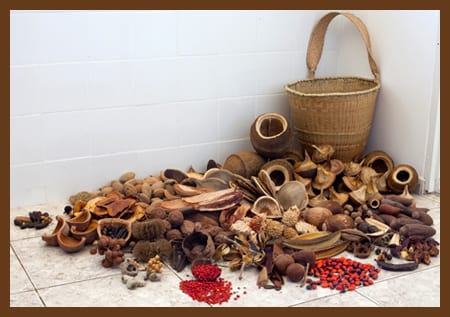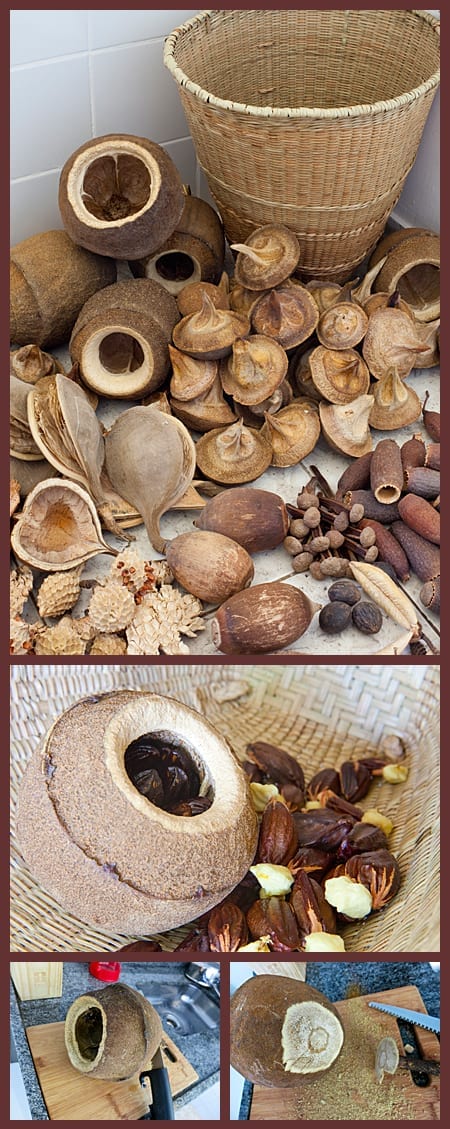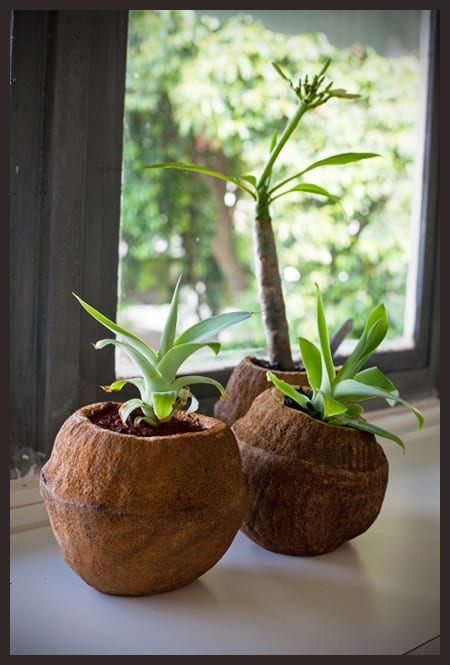Open your mouth and repeat after me: “SA-PU-CA-IA!”
I know a month and a half ago I posted what was to be my last text on the blog, but these things happen constantly and if politicians make a living of it I too am fully entitled to say one thing and do the other with a smile. To ease into this embarrassing return let’s have this post just be about seeds, the symbol of beginnings and continuations.
Having always been fascinated by nuts, kernels, husks, seeds and fruit my arrival in Brazil is a blessing on the verge of becoming now the curse that engulfs my life. The familiar handful of seeds with faded appeal back home in Spain have been drowned by a bountiful world of Dr. Seuss bushes, palms and giant trees that compete to astound and feed us all here in Brasilia. Be careful with what you wish for…
It is bizarre to feel so much like a gatherer primate in the middle of a city of 5 million, but the brief history of this envisioned-in-a-dream capital allows for big sections of the Brazilian savanna to sprawl into its very heart while paradisiac weather conditions do the rest: rational urbanism and practical landscaping have turned us into alert, hungry, competing monkeys. Everyone is ready to climb the branches of lime, avocado, mango, papaya, guava and passionfruit trees or make expert visits to lesser known national treats with mouthwatering names like pequi, jabuticaba, jenipapo, caju*, jaca**, caja manga or graviola. This has to be a phenomenon that goes unnoticed to the (very few) foreign tourists visiting us, quiet peaceful folks who cannot imagine any city as one mammoth fruit orchard. Here though, “amongst us locals”, it is an open war, a race for the next juicy treat. Some fruit even gets picked before ripe, simply to make sure nobody else keeping track of its progress steals it away first. We all walk around scanning foliage and soil, taking quick geotagged mental notes, changing the route to the office and the supermarket to cover extra ground. Mango season is around the corner and things are beginning to get tense and will soon turn nasty. I have visions of businessmen in suitcases stopping along the highway and elatedly filling with sappy hands the trunks of their imported cars, a bruised knee or scraped jacked here and there is a small price to pay, thousands of schoolchildren with yellow mouths and sugar-rush vampirish eyes unable to keep track of the lesson. Oh, so many stomach aches.
But too much of a good thing can make you lose your mind (e.g. Don Quixote). In my case, I feel a greedy urge to take all the nuts home, know where and when those colorful ornamental seeds can be collected and the consequence is that the shoebox apartment that my girlfriend generously shares with me looks more and more like the tropical chipmunk version of the horn of plenty, the horn being a Kayapo indian gathering basket and the plenty thousands of beautiful, “indispensable” (or tasty) beauties that have spilled out of drawers and boxes into the kitchen floor. A token:

“And the sapucaia?”, I hear you say. The sapucaia tree is mother to the queen of all nutshells: huge, heavy, beautiful, impossible, hard as a rock and in season as I write these rushed lines. This vegetal capsule could be described as a massive vase or helmet of sorts made from an ironwoodish material and possessing a giant pushpin lid that pops out like a soda bottle when the nuts inside are in their prime. Jungle monkeys go crazy for them and try to speed the ripening process by half breaking the branch with violent twists of the impenetrable ball. It is said you will never see a monkey stick its hand inside the nutshell for fear of not getting it out once filled with seeds; they prefer to shake the pot and collect from the ground. To cut a nutshell is no small feat, it is a task that knows no shortcuts and requires absolute resolution and stamina. You have to climb the tree (that can grow above 160 feet) and to get to the tip of the exterior branches, where the nutshells capriciously grow. Then you can either use the monkey technique and twist with all your might for a few minutes in both directions until the tough branch finally gives or you can benefit from being a modern man with hardware stores in every streetcorner and use a Fiskars pruning saw while holding on with legs, teeth and the remaining arm to the mighty sapucaia tree in a voluptuous high altitude dance. 
Sadly, between both people and monkeys sapucaias have become an endangered tree almost doomed by this dangerous cocktail of rampant deforestation and monkey feasting. It would be easy to dip head first at this point into a sad soliloquy, but hey, we are in the middle of a light hearted story: Right around where we live there are a few sapucaia trees that a handful of us, the more experienced Brasilienses, know and periodically check. They are right between the worksite for the upcoming bicycle trail network that will soon transform the city (this being another story of seeds, the seeds of change that are wind spreading worldwide) and a gas station (this, on the contrary, hopefully being a tale of upcoming extinction). On Sundays we gather under them, the purple and green sapucaias: the curious passing by monkeys that watch from the side, the hard working monkey endlessly throwing a rotten nutshell, a rock or a stick up in the hope of hitting the small piñatas and being showered with nuts, the deceivingly-fragile-scavenging-female monkey that follows the hard working monkey, pointing to everyone that wants to listen to the shakeable nutshells in the “very easy to climb for a man” trees while shamelessly stealing the fruit of the other monkey’s labor… and there is me, the pinnacle of evolution at this point, the Fiskars monkey. I risk my life in the most absurd fashion and climb the tree, saw off three or four nutshells and greedily take them home in a bag. Here we eat, store and take pictures of such impossible works of nature, create crafty uses for them to post on Ecodesigns and grow a little army of baby sapucaia trees to plant in our favorite spots and continue fighting the power back and feeding the hungry monkey that lives in all of us. Go for small actions that just like seeds hold the power of rebirth and change. The city CAN feed with no CO2 footprint.
A video playfully made with the photo camera a while back at the Natural History Museum in Paris, during a commemorative Darwin exhibit. Music by the mighty Sigur Rós to welcome myself back to the blog. “On the Decay of Species”:
*Cashew tree
**Jackfruit tree


